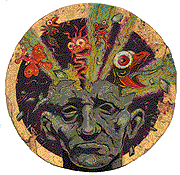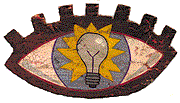

Like a rocket engine that shuts down from fuel exhaustion, many creatives burn out or falter and fall. How can we restart the engine and climb back to the idea space? How can we maintain our creative fuel and avoid burning out?
The key is finding inspiration and drawing on it for creative nourishment. In a recent presentation to the Freelance Forum, Bob Wages of Wages Design said, "Inspiration is inhaling - it's what you bring into your life - it affects how you work and the people you work with."
What inspires some people, may not affect others, but here is a sampling of inspirational suggestions to help jump-start creativity.
"If ever I feel blocked or stumped, I take the day off," says Elizabeth O'Dowd, Vice President and Chief Creative Officer at BrightHouse. "Most creative people forget the most important step in the creative process - incubation. I read, see a movie, go to the zoo, visit my four-year-old at daycare - I let my subconscious do all the work."
The type of creative getaway and its length will vary with the individual. Other effective suggestions include:
1. Meditate. For Arrington Hendley, Photographer, a ten-minute meditation break seems to work. "I hide somewhere, in a calm place where I can put everything out of my mind."2. Enjoy a Hobby. Writer Kathy Couch, of Couch Communications, Inc., clears her mind and receives inspiration from gardening. "Weeding is a great metaphor for trying to order my brain," she says.
Hendley prefers painting watercolors. "I'm awful at it, but I'm getting better," he says. "Age and patience has taught me how to work with the medium, and I get a lot of pleasure out of it now."
3. Listen to Music. Wages and O'Dowd become inspired by music. For Wages, jazz, classical, Broadway musicals, standards and oldies get him going. O'Dowd turns to "any music by Elvis Costello, because he is truly creative."4. Attend a Performance. Jennifer Singh, Illustrator and Graphic Designer, drifts during concerts or theatre performances. "In the dark, I can let my mind go," she says. "I find myself wandering off, daydreaming, and then I'll think about a painting."
5. Play. "All creative people are kids at heart," says Producer/Director Steve Carmichael, of Steve Carmichael Productions. "You've got to play - do stuff that's definitely not work to get off the linear approach to creative work. I keep yo-yos in my office and I play solitaire on my computer."
6. Take a Trip. For Designer Hal Smith, Vice President and Creative Director of Critt Graham + Associates, travel provides a new perspective. "I look at the ways other cultures and people communicate, and it helps me view things differently."
If an out of town trip is not possible at the moment, try a vacation in your mind. "When I ride my motorcycle, I can get a week's vacation in five minutes," notes Carmichael.
7. Go to a Gallery or Art Show. "It's something I don't do nearly enough," says Singh, "but, I get really inspired by other artists' work."8. Work in a Different Medium. Singh also turns to media other than her usual watercolor and pastels when things become a bit too predictable. "If you force yourself to work in different media, you can get yourself out of that predictability," she says. "I try sculpting or collage, anything to come up with something different."
9. Have Fun with Techno-Toys. Many people view computers and the technology they have spawned as the ultimate toys. For Carmichael, the constantly changing technology is invigorating. "It's very exciting," he says. "So much is new in film and video production, and the toy box gets bigger every year. I keep up with the technology and mentally file techniques away until I find an appropriate use for them."

10. Exercise. Author Julia Cameron, in her book, The Artist's Way, advocates a brisk 20-minute walk to boost creativity. For Smith and Singh, running helps to clear the cobwebs and restore balance. "Designers tend to work too much," notes Smith. "My wife and I run together and that helps me put balance back in my life." Couch prefers clearing her mind with Tai Chi or a walk in the woods.
11. Seek the Ultimate Creator. Wages says, "Whatever brings spirituality to you is important, it shows up in everything you do."
12. Theory Books. "I keep a lot of design theory books around," says Smith, "and I go back and read about the basics of problem-solving. When I'm stymied, sometimes this reference material kick-starts my thought process. I also look in the dictionary or thesaurus for word concepts."13. Master Works. Hendley returns to his first love, classical paintings. "The photographs I make are almost storybook," he says, "and I get a lot of inspiration from looking at paintings."
14. Personal Projects. Hendley also recognizes the importance of pursuing projects on his own. "I spend two or three hours a week thinking about things I'd like to photograph, or other art projects, and I jot down my ideas," he says.
15. Brainstorming. "I like to bounce ideas off of a creative friend, or my husband, or work with a designer," says Couch. "I can usually get something started with another person. We begin throwing out silly things, then gradually narrow the ideas down."
Smith agrees, saying clients and co-workers are great sources of inspiration. "We are trying to get more of a collaborative effort going among our designers," he says. "We've got an incredible brain trust here, and we need to leverage that creative talent."
For Wages, inviting other designers into the process dramatically improved his design. "I used to be the 'Imperial Designer', everything that went out was my design," he says. "Then, the pressure made me start to share the work. I stopped being a 'me' company, now everything is 'we', an ensemble, and the work is better."
16. The Talent Rush. Thinking about the talents of the crew he will put together inspires Carmichael. "I get really motivated thinking about the people who will work with me on a project," he says. "I think about their individual talents and how these will boil over into a creative stew."

17. Enjoy the Surroundings. Work environment can play a big role in creativity. Wages works in a big open room where he can, "look at trains all day." Singh loves working at home in her quiet neighborhood, where she can sit on the screened porch and contemplate wildlife.
O'Dowd says, "There is no better environment than BrightHouse. We actually work in a house, a long way from the black leather and steel penthouse of the 80's. You must be relaxed to be creative, and I don't understand how people can be creative in those ugly tall buildings."
18. Appreciate The Family. "I believe that family is nourishment for the creative process," observes Carmichael. "It's the ultimate break, and there is no substitute for what we get from our loved ones. It's so different from what we do in work, but we've got to have that balance."19. Trust Your Instincts. Often, we second-guess ourselves and our ideas, and that hampers creativity. Remembering our strengths and taking pride in our work can be inspirational. "Part of being creative is putting yourself out there," says Singh. "If you are self-conscious of your ideas, it's more difficult to let them flow. Ultimately, you have to trust yourself."
Carmichael agrees, extending the self-trust into the types of work he tries to get. "I won't offer myself to a client unless I'm enthusiastic about the project," he says. "If I have to struggle, it will show in the work, just as my enthusiasm will show."
20. Be Open - Allow For Serendipity. Creative ideas can come from weird places, and we have to be open to receive them. Sometimes that's hard to remember when an outline or storyboard is done, the design has been approved, or the set is up for the photo shoot. But, if we remain open to inspiration, we may be able to improve our work by embracing a new idea. "You have to allow for serendipity," advises Carmichael. "It will happen even on the most tightly controlled production, and you have a choice, you can go with it or fight it. I find my productions are better if I invite it in."
Hendley agrees, "Often, I'm not unhappy with where a shot is, but then I'll have a realization that takes the idea further. I usually leave my set-ups as long as possible so I can jump in and do another version if I feel I should. I tend to change things more often, but it makes a big difference to me."
When the creative ideas emerge, most people try to be prepared by having a pad of paper and a pen handy to write them down. Glove compartments and bedside tables are among the preferred locations for note pads.
One of the biggest things we must remember is that creative blocks happen to nearly everyone, and a lot of creatives do burn out. "It was important for me to accept that this is normal," says Couch. "To avoid it, I try to have a balanced life, a steady stream of stimulus coming in. I try to feed my brain and my creative engine by not working all hours of the night under tremendous pressure."
Couch says she's also developed a process to start her engine. As an initial exercise, she sits down with a new project for about an hour. "I try to have no expectations. I just start writing, mostly stream of consciousness stuff. Then, I put it away and do something else. When I come back to it the next day, I have a starting point. If the flash is going to happen, it happens somewhere else and it's more likely to happen if I've started the process."
The fact that we tend to get our "Ahas" when we're doing something else, sleeping, driving, showering, etc., suggests that they are in our brains all along, fueled by the various things that inspire us. "We process an unbelievable amount of inspiration every day," observes Smith. "It's all in there. Every designer or writer I know talks about something that 'just clicks.' I think it's about discovery. The ideas are there, we just have to find them."